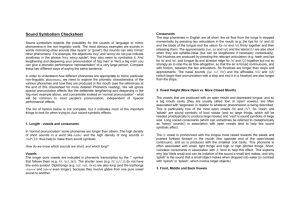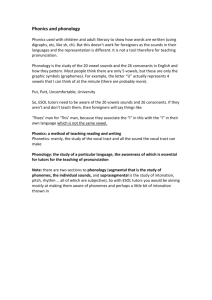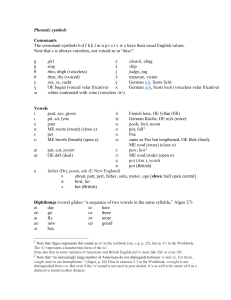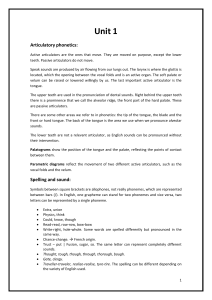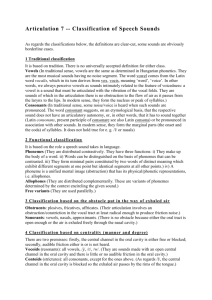Checksheet 5 – Phonetic Symbols
advertisement
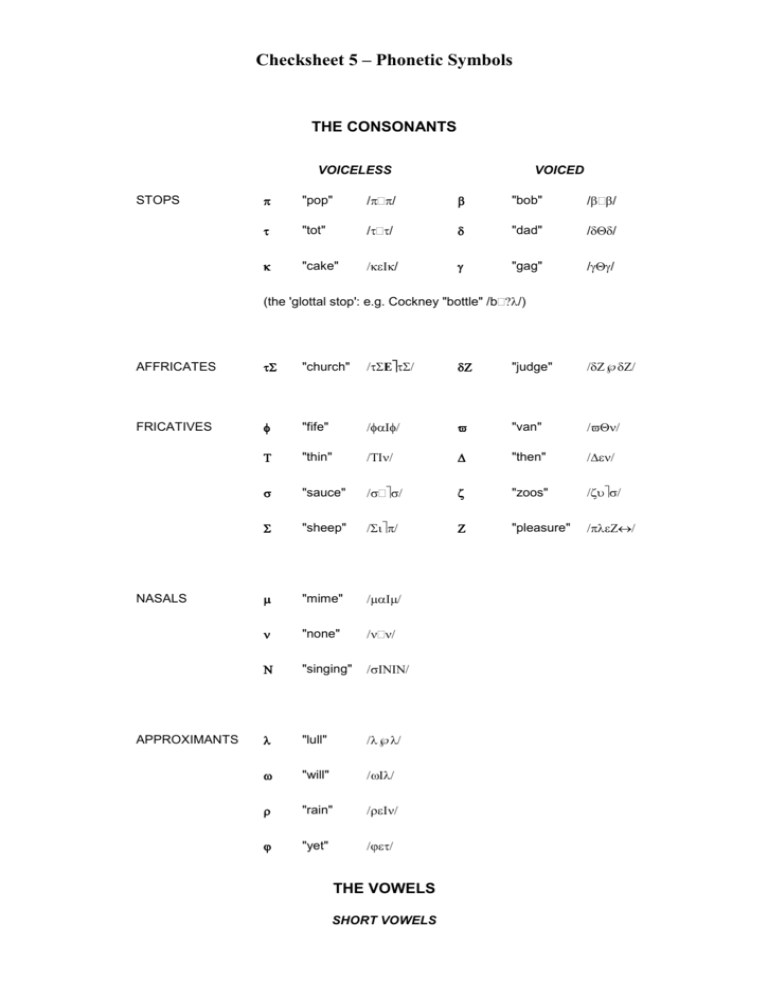
Checksheet 5 – Phonetic Symbols THE CONSONANTS VOICELESS STOPS VOICED "pop" // "bob" // "tot" // "dad" // "cake" / "gag" // (the 'glottal stop': e.g. Cockney "bottle" /b/) AFFRICATES "church" /E/ "judge" // FRICATIVES "fife" // "van" "thin" "then" "sauce" "zoos" / "sheep" "pleasure" "mime" "none" "singing" "lull" "will" "rain" "yet" NASALS APPROXIMANTS THE VOWELS SHORT VOWELS FRONT MIDDLE BACK ("rid", ) HIGH MID LOW ("bed", ) ("about", ) ("bud", ) ("cat", ) ("could", ) ("cod", //) LONG VOWELS FRONT MIDDLE HIGH ("reed", ) BACK ("mood", ) E ("bird", Ed) MID LOW THE DIPTHONGS ("law", //) ("kart", //) THE TRIPTHONGS "raise" // "fire" // "rose" // "hour" // "rise" // "rouse" // "toy" // "beer" // "there" // "cure" // Sound Symbolism Sound symbolism exploits the possibility for the sounds of language to mimic phenomena in the non-linguistic world. The most obvious examples are sounds in words mimicking other sounds (like 'quack' or 'growl'). But sounds can also 'mimic' other phenomena. For example, the adjectives incy' and 'wincy' do not just indicate smallness in the phrase 'incy wincy spider', they also seem to symbolise it. And lengthening and deepening your pronunciation of 'big man' in 'He's a big man' you can give a phonetic performance 'representation' of a very large person. Compare these two different ways of saying the same sentence. In order to understand how different phonemes are appropriate to mimic particular non-linguistic phenomena, we need to explore the phonetic characteristics of the various phonemes and how they are produced in the mouth (see the references at the end of this checksheet for more detailed Phonetics reading). We will ignore special pronunciation effects like the deliberate lengthening and deepening in the 'big man' example above, and concentrate instead on 'normal pronunciation' - what will be common to most people's pronunciation, independent of 'special performance' effects. The list of factors below is not complete, but it indicates most of the important things to look for when trying to chart sound-symbolic effects. 1. Length - vowels and consonants In 'normal pronunciation' some phonemes are longer than others. The high density of short sounds in a word like and the high density of long sounds in thus help to make them sound symbolic. How do we know which sounds are short, and which long? Vowels The longer pure vowels are indicated in phonemic transcription by the ':' symbol that follows them (e.g. /i:/, /u:/, /a:/). The shorter ones (e.g. //, //,//) do not have this extra symbol. Diphthongs (e.g. //, //, //) are also long (and the tripthongs -// and // even longer), because they involve glides from one pure vowel sound to another. Consonants The stop phonemes in English are all short: the air flow from the lungs is stopped momentarily by pressing two articulators in the mouth (e.g. the lips for // and // and the blade of the tongue and the velum for // and //) firmly together and then releasing them. The approximants (//, // and //) and the lateral // are also short when they are syllable-initial (but can be lengthened if necessary contextually). The fricatives are produced by pressing the relevant articulators (e.g. teeth and lips for // and //, and tongue tip and alveolar ridge for // and //) together but not so strongly as to stop the air flow altogether, so that the air is forced continuously, and with friction, between the two articulators. So fricatives are longer than stops and approximants. The nasal sounds (//, //, //) and the affricates // and // (which begin their pronunciation with a stop and end it in a fricative) are also longer than the stops. 2. Vowel Height (More Open vs. More Closed Mouth) The vowels that are produced with an open mouth and depressed tongue, and so a big mouth cavity (they are usually called 'low' or 'open' vowels), are often associated with 'largeness' in relation to whatever phenomenon is being described. This is particularly true of the most open vowels // and //. So 'crash' and 'splash' are sound symbolic of loud noises (and so large things, which will be needed prototypically to produce large noises) and 'vast' is sound symbolic of large size. Long voiced consonants (which can sometimes be referred to metaphorically as 'heavy' sounds') in association with open vowels tend to help this sound symbolic effect. The vowel is pronounced with the tongue most raised towards the palate and pushed furthest forward in the mouth (the opposite end of the open/closed continuum), and so is produced with the smallest oral cavity. This phoneme is often associated with small, light things and high or high pitched things. Short, voiceless consonants in association with tend to help this effect. This explains why 'pip' feels small and can be imitative of the sound a small bird makes, and why 'splish' is the sound that a small object makes when dropped into water (in contrast with 'splosh' or 'splash', which involve larger objects). 3. Front, Middle and Back Vowels Vowels are distinguished not just in terms of their height, but also in terms of where they are positioned from front to back in the mouth. This is controlled by whether or not the blade of the tongue is (i) raised, and (ii) pushed forward or not. Try moving slowly from the pronunciation of // to // and you should be able to feel that front of the tongue stays in roughly the same position, but the back of the tongue blade moves down. If you go from // to // to // you should feel the tongue receding further and further back, while retaining the mid-position in terms of height. Vowels which are produced further back in the mouth are often felt to symbolise indistinctness in some way, particularly if they are accompanied by nasal consonants (cf. 'gloom', 'boom'). 4. Voiced vs. Unvoiced Consonants Many of our consonants are arranged in articulatory pairs which vary according to whether they are voiced or not. So // and // are both bilabial stops, but // is voiceless and // is voiced. // and // vary with respect to voicing but are both velar stops. // and // are both labio-dental fricatives, varying with respect to voicing. Try putting your fingers in your ears and moving from saying a lengthened // to a lengthened // to feel the voiceless/voiced difference. In general terms, voiceless vowels 'feel' lighter than voiced ones. Compare // with // and // with //. The voiceless forms seem to mimic lightness and you will probably say these words at a higher pitch level than their voiced counterparts. 5. Obstruence or Sonority There is a hierarchy of obstruence, or sonority, for consonants, related to how hard the articulators have to be pressed together to achieve the various sounds. Stops need the most pressure, fricatives a bit less, and so on: Oral stops Affricates Fricatives Vless V-d Vless Vless V-d * V-d Most obstruent Nasals Approximants Least obstruent Abbreviations: V-d = voiced; Vless = voiceless. There is a tendency for the more obstruent phonemes to symbolise loudness, strength and so on, and for the less obstruent phonemes to be associated with lightness. Compare // and // in 'He rammed the door shut' and 'He clicked the door shut'. Appropriate vowels and/or voiced/voiceless consonant contrasts will make the opposition feel even greater, of course. 6. Phonaesthetic Series There are some sets of sounds which are not sound symbolic of themselves, but tend to have similar sorts of effects because they are part of what is usually called a phonaesthetic series. These are clusters of phonemes which take on sets of associations because it just happens accidentally that they turn up a lot (but not always) in words with similar meanings or associations. A good example is the wordinitial consonant cluster //, which often begins words associated with light e.g. 'gleam', 'glint', 'glitter', 'glisten'. As a consequence, even though there are some words beginning with /gl/ which definitely do not have such connotations (e.g. 'glebe'), other words beginning with // can take on 'light' associations if they are felt to be appropriate (e.g. 'glad', 'glee'). Another example (although the // at least is arguably properly sound symbolic) is the // sequence which begins lots of words connected with the interaction between two lubricious surfaces: 'slippery', 'slide', 'slime' and so on. Again, not all words beginning /sl/ have 'slushy' connotations (cf. 'slat' and 'slag'), but the // word-initial phonaesthetic series explains why the word 'slug' seems phonemically appropriate for the creature it refers to. 7. Mimicry on Other Language Levels As this checksheet is concerned with sound symbolism, we will not deal in any detail with linguistic structure/world mimicry at other linguistic levels. But it is worth bearing in mind that such effects do occur. It is easy to see it in graphological terms: Compare: little and LARGE where changes in font size, lower/UPPER case and emboldening are all involved in making a semantic opposition visual This is how so-called 'concrete poetry' gets many of its effects, of course. There are also grammatical effects which can be thought to be symbolic too. So, the sentence 'Suddenly down they fell' with its fronted adverbials will probably be felt to 'mimic' better the perception of seeing some people suddenly fall down than 'They fell down suddenly'. 8. A Final (Repetition of) a Warning Linguistic symbolism, including sound symbolism, is all around us. But as we have pointed out on the main sound symbolism page, linguistic arbitrariness is more common by far than linguistic symbolism. So be careful that you don't end up seeing it where it doesn't exist! I don't think there is much that is ghostlike about the phonemic composition of the word 'ghost', for example (though one could make a better case for 'will o' the wisp'!). Sound Symbolism and Sound Patterning References: Bolinger, Dwight (1980) Language, the Loaded Weapon, ch. 3. Epstein, Edmund L (1978) Language and Style, Methuen, ch. 3 Knowles, Gerry (1987) Patterns of Spoken English, Longman, pp. 38-42, 60-63, 84-8, 113-4. Leech, Geoffrey. N. (1969) A Linguistic guide to English Poetry, Longman, ch. 6 Short, Mick, (1996) Exploring the Language of Poems, Plays and Prose, Longman, ch. 4. Wales, Katie (1990, 2001) A Dictionary of Stylistics, Longman, entries for sound symbolism, onomatopoeia, phonaesthesia etc. Phonemics references: Rogers, Henry (2000) The Sounds of Language: An Introduction to Phonetics, Longman. Knowles, Gerry (1987) Patterns of Spoken English, Longman.
